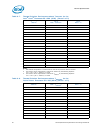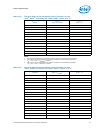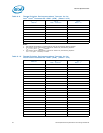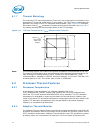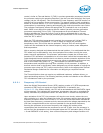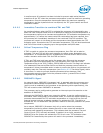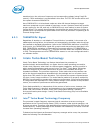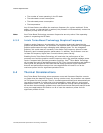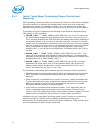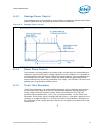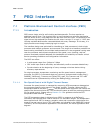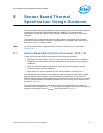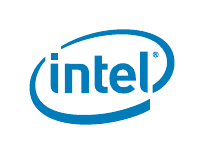
Thermal Specifications
58 Thermal/Mechanical Specifications and Design Guidelines
transitioning to the minimum frequency and corresponding voltage (using Freq/VID
control). Clock modulation is not activated in this case. The TCC will remain active until
the system de-asserts PROCHOT#.
Use of PROCHOT# in bi-directional mode can allow VR thermal designs to target
maximum sustained current instead of maximum current. Systems should still provide
proper cooling for the VR, and rely on PROCHOT# only as a backup in case of system
cooling failure. The system thermal design should allow the power delivery circuitry to
operate within its temperature specification even while the processor is operating at its
Thermal Design Power.
6.2.3 THERMTRIP# Signal
Regardless of whether or not Adaptive Thermal Monitor is enabled, in the event of a
catastrophic cooling failure, the processor will automatically shut down when the silicon
has reached an elevated temperature (refer to the THERMTRIP# definition in the EDS).
At this point, the THERMTRIP# signal will go active and stay active as described in the
EDS. THERMTRIP# activation is independent of processor activity. If THERMTRIP# is
asserted, processor core voltage (V
CC
) must be removed within the timeframe defined
in EDS. The temperature at which THERMTRIP# asserts is not user configurable and is
not software visible.
6.3 Intel
®
Turbo Boost Technology
Intel
®
Turbo Boost Technology is a feature that allows the processor to
opportunistically and automatically run faster than its rated operating core and/or
render clock frequency when there is sufficient power headroom, and the product is
within specified temperature and current limits. The Intel
®
Turbo Boost Technology
feature is designed to increase performance of both multi-threaded and single-
threaded workloads. The processor supports a Turbo mode where the processor can
utilize the thermal capacitance associated with the package and run at power levels
higher than TDP power for short durations. This improves the system responsiveness
for short, bursty usage conditions. The turbo feature needs to be properly enabled by
BIOS for the processor to operate with maximum performance. Since the turbo feature
is configurable and dependent on many platform design limits outside of the processor
control, the maximum performance cannot be guaranteed.
Turbo Mode availability is independent of the number of active cores; however, the
Turbo Mode frequency is dynamic and dependent on the instantaneous application
power load, the number of active cores, user configurable settings, operating
environment and system design. Intel
®
Turbo Boost Technology may not be available
on all SKUs.
6.3.1 Intel
®
Turbo Boost Technology Frequency
The processor’s rated frequency assumes that all execution cores are running an
application at the Thermal Design Power (TDP). However, under typical operation, not
all cores are active. Therefore most applications are consuming less than the TDP at the
rated frequency. To take advantage of the available TDP headroom, the active cores can
increase their operating frequency.
To determine the highest performance frequency amongst active cores, the processor
takes the following into consideration:



